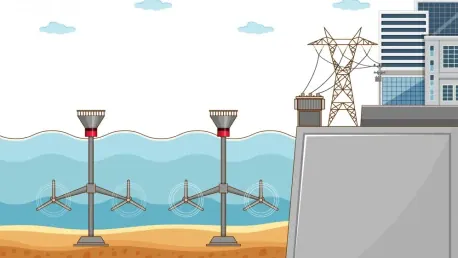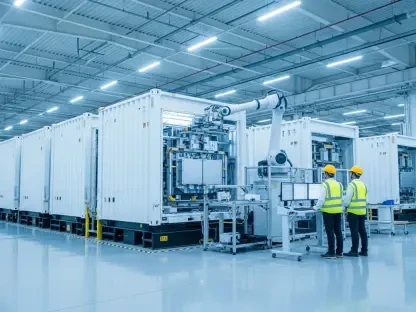In the quest for renewable energy solutions capable of meeting increasing electricity demands while minimizing environmental impact, tidal range energy has emerged as a vital contender. The Severn estuary, known for its high tidal range, offers substantial potential for generating renewable electricity that is predictable and independent of weather conditions. Experts from the Severn Estuary Commission argue that this resource could contribute significantly to the UK’s electricity needs, particularly as the country faces growing energy consumption due to the rise in electric vehicles, the electrification of heating and industry, and expanding data center operations.
Tidal Range Energy Potential
The Promise of Renewable Energy in the Severn Estuary
A panel of experts has assessed the potential of harnessing tidal range energy in the Severn estuary, emphasizing its ability to provide a steady and reliable source of electricity, independent of sun and wind conditions. According to the commission, chaired by Dr. Andrew Garrad, the estuary could generate between 8 to 12 gigawatts of energy, accounting for up to 7% of the UK’s electricity demand. The Severn Estuary Commission is a group formed by the Western Gateway “powerhouse,” consisting of specialists from various fields who have consulted with stakeholders to arrive at their recommendations.
Despite the considerable promise, the commission advises against the construction of a large, dam-like barrage due to numerous concerns. Instead, they advocate for smaller, more manageable lagoon models that appear to balance environmental, legislative, and commercial interests better. The experts stress the importance of carefully considering ecological factors before developing tidal range projects. The estuary holds substantial ecological significance and demands strategies aligned with environmental sustainability.
Balancing Energy with Ecological Protection
Given the ecological importance of the Severn estuary, any energy development plans must prioritize environmental protection alongside economic benefits. The commission’s final recommendations include pursuing lagoon projects rather than opting for massive infrastructures that might harm the local ecosystem. Lagoon projects are seen as a viable alternative by the Welsh government, offering renewable energy while contributing significantly to economic growth. It’s estimated that such projects could add £12 billion in gross value added (GVA) and generate 220,000 job years during the construction phase.
Balancing these aspects is crucial to ensuring the estuary’s health and sustainability while leveraging its renewable energy potential. Lagoon models provide a method for harnessing tidal energy without causing extensive damage to the environment. They offer a pathway to green energy that aligns with both economic and ecological goals. Various stakeholders have supported this approach, encouraging collaboration between the UK and Welsh governments in moving forward with these projects.
Future Considerations
Immediate Action and Government Support
The commission urges for immediate steps to be taken in developing tidal range energy projects in the Severn estuary. Both the UK and Welsh governments have shown support for lagoon projects, recognizing the dual benefits of renewable energy and economic growth. As policymakers continue to seek sustainable and innovative solutions to meet future energy requirements, the Severn estuary’s tidal range energy potential cannot be overlooked. This approach promises not only to address energy demands but also to foster a sustainable and ecologically responsible development process.
Economic Gains and Sustainable Goals
Beyond mere energy generation, developing tidal range projects in the Severn estuary offers considerable economic advantages. The construction phase alone can provide numerous job opportunities, massively contributing to local and national economies. With an estimated £12 billion in GVA, the potential economic uplift underpins the value lagoon projects could bring. This economic growth, powered by sustainable practices, aligns with long-term goals of renewable energy utilization and environmental stewardship.
While the Severn estuary’s enormous tidal range presents major energy development opportunities, it’s essential to balance sustainable growth with ecological preservation. By choosing lagoon projects, stakeholders envisage a harmonious blend of energy production, environmental protection, and economic growth. The dual emphasis on ecological sustainability and economic development reaffirms commitment to responsible energy practices and sets a precedent for future renewable energy initiatives.
Path to a Sustainable Future
Aligning Technological Innovation with Environmental Preservation
The role of technological innovation in the realm of tidal energy cannot be overstated. Advances in energy technology offer pathways to harness the Severn estuary’s tidal power more effectively while minimizing environmental impact. Lagoon models represent such innovations, providing a promising alternative to traditional dam-like structures. As technology evolves, optimizing these lagoon systems will be crucial for ensuring efficient energy production, maximizing economic benefits, and preserving the estuary’s delicate ecological balance.
Collaborative Efforts and Long-Term Planning
In the pursuit of renewable energy solutions that meet rising electricity demands while reducing environmental impact, tidal range energy has become a key player. The Severn Estuary, renowned for its significant tidal range, holds great promise for generating renewable electricity that is both predictable and weather-independent. Experts from the Severn Estuary Commission emphasize that this resource could play a crucial role in meeting the UK’s electricity requirements. This is especially relevant as the nation’s energy consumption grows, fueled by the increasing adoption of electric vehicles, the electrification of heating and industry, and the expansion of data center operations. By harnessing the natural power of tidal range in the Severn Estuary, the UK could make substantial strides toward cleaner, more reliable energy. This potential for consistent and renewable electricity supply represents a valuable opportunity as the country continues to move towards a sustainable energy future.









